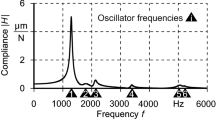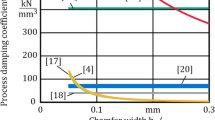Abstract
The use of chamfered tools is widely spread in cutting processes. Prior investigation show, that a chamfer on the rake face of a milling tool can increase the stability of cutting processes significantly due to a contact between the chamfer surface and the workpiece and the resulting damping forces. In addition to higher process stability, it is possible that the chamfer shows positive effects on the machined surface as well. A sufficient chamfer length can cut off the feed marks on the machined surface, but also damping effects on the process vibrations can lead to a better flank surface when milling compliant parts or tools as well. This paper describes an approach of simulation of machining of the flank surface with consideration of the chamfer geometry. In the experimental and simulative investigations it was found that by the reduction of extensive workpiece vibrations, the chamfer does have positive effect on the flank surface quality due to a contact between the chamfer and the workpiece. Furthermore, this contact does apparently occur earlier than a theoretical consideration would predict from the kinematics of the process. With increase of the chamfer length on the other hand, also augmented appearance of smearing effects on the surface, which decrease the surface quality, was observed.














Similar content being viewed by others
References
Brecher C, Manoharan D, Ladra U, Köpken H-G (2009) Chatter suppression with an active workpiece holder. Prod Eng Res Dev 4:239–245
Denkena B, Bickel W, Ponick B, Emmrich J (2011) Dynamic analysis of a motor-integrated method for a higher milling stability. Prod Eng Res Dev 5:691–699
Lange M (2006) Hochleistungsfräsen von Aluminium-Strukturbauteilen. In: Proceedings of the 7th Schmalkalder Werkzeugtagung, 08/09 Nov 2006, Schmalkalden
Yen Y-C, Jain A, Altan T (2004) A finite element analysis of orthogonal machining using different tool edge geometries. J Mater Process Manuf 146:72–81
Al-Athel KS, Gadala MS (2011) The use of volume of solid (VOS) approach in simulating metal cutting with chamfered and blunt tools. Int J Mech Sci 53:23–30
Yusoff AR, Turner S, Taylor CM, Sims ND (2010) The role of tool geometry in process damping milling. Int J Adv Manuf Technol 50:883–895
Budak E, Tunc LT (2010) Identification and modeling of process damping in turning and milling using a new approach. CIRP Ann-M 59:403–408
Ahmadi K, Ismail F (2011) Analytical stability lobes including nonlinear process damping effect on machining chatter. Int J Mach Tool Manuf 51:296–308
Rahmana R, Sajjadi M, Park SS (2009) Chatter suppression in micro end milling with process damping. J Mater Process Tech 209:5766–5776
Weinert K, Kersting P, Surmann T, Biermann D (2008) Modeling regenerative workpiece vibrations in five-axis milling. Prod Eng Res Dev 2:255–260
Denkena B, Köhler J, Sellmeier V, Mörke T (2011) Topography prediction of resilient parts after flank milling with chamfered tools. Prod Eng Res Dev 5:273–281
Engin S, Altintas Y (2001) Mechanics and dynamics of general milling cutters. Part I: helical end mills. Int J Manuf Sci Eng 41:2195–2212
Chang C-S (2000) Prediction of cutting forces for the milling of plain carbon steel using chamfered main cutting edge tools. J Mater Process Tech 105:302–326
Choudhury IA, See NL, Zukhairi M (2005) Machining with chamfered tools. J Mater Process Tech 170:115–120
Acknowledgments
The authors would like to thank the German Research Foundation (DFG) for supporting the presented work (De 447/69-1).
Author information
Authors and Affiliations
Corresponding author
Rights and permissions
About this article
Cite this article
Denkena, B., Bickel, W. & Sellmeier, V. Flank milling of compliant workpieces with chamfered tools. Prod. Eng. Res. Devel. 6, 403–412 (2012). https://doi.org/10.1007/s11740-012-0399-1
Received:
Accepted:
Published:
Issue Date:
DOI: https://doi.org/10.1007/s11740-012-0399-1




